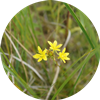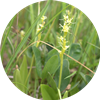Alkaline fens
Numbers corresponds with numbers on the board
1.
Alkaline fens are a specific type of mires – they are fed with groundwater rich in calcium ions, which causes that their water reaction is usually alkaline (hence the name). In Poland, they occur most frequently in the north-west and north-east of the country and in the mountains. In Lubuskie Voivodship, Pliszka and Ilanka river valleys are the sites of well-preserved alkaline fens complexes – many of them are protected as reserves (e.g. Dolina Ilanki, Mechowisko Kosobudki or Jezioro Ratno). All are protected under the Natura 2000 network. The most known alkaline fens in Poland are those in Rospuda Valley or Biebrza Marshes.
Map legend
 Places of occurrence of alkaline fens in Poland
Places of occurrence of alkaline fens in Poland
 Pliszka and Ilanka valleys
Pliszka and Ilanka valleys
How do you protect them?
2.
As with all types of mires, the construction of peat or wooden dams on drainage ditches is one of the basic methods for restoring proper water conditions. Often, in a relatively small area, it is necessary to build several dams to keep water within the mire. In the case of alkaline fens, the most important thing is that the water table does not rise above ground level and that the water can freely filter through the peat.
3.
On drained mires, the expansion of cane, grasses, as well as bushes and trees begins. This phenomenon additionally drives drainage of the area (through increased uptake of roots and evapotranspiration). Therefore, alkaline fens are often mown and new bushes and trees are periodically removed. This restores both the right light (no shading) and water (less water intake) conditions.
What is so valuable in them?
4.
Despite their unassuming appearance, among the mosses occurring on alkaline fens there are species that are glacial relics and thus occurring in this area since the glaciation (about 500,000 years ago). For comparison, it can be stated that other glacial relics found in Poland are cloudberry, Lapland willow, or White-backed hare. Below are some inconspicuous but extremely valuable species of alkaline fens.
 Angled paludella moss Paludella squarrosa, glacial relic of alkaline fens
Angled paludella moss Paludella squarrosa, glacial relic of alkaline fens
 Yellow marsh saxifrage Saxifraga hirculus – very rare, occurs only in a few places in Poland
Yellow marsh saxifrage Saxifraga hirculus – very rare, occurs only in a few places in Poland
 Fen orchid Liparis Loeselii – an inconspicuous orchid growing only on well-preserved alkaline fens
Fen orchid Liparis Loeselii – an inconspicuous orchid growing only on well-preserved alkaline fens
How they are built?
5.
The above photo of Ilanka valley in the vicinity of Lake Pniów and the diagram illustrate how water leaking from the mineral plateau flows into the fen and then seeps towards the river (receiver). During its journey, the water acquires alkaline properties – it is saturated mainly with calcium and magnesium ions – thanks to which the characteristic flora of peat bogs is shaped. The migration of water and its outflow to the fen using the so-called the “hydrological window” (holes in the impermeable layers, a specific spring) are crucial for the protection of alkaline fens, as they shape their character.













